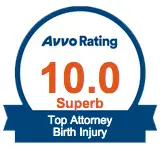Compound presentation occurs when the part of the fetus closest to the birth canal (usually the head) presents with an extremity next to it (usually hand or arm) (1). It has been estimated to affect less than 0.004% of pregnancies.
What are the causes of compound presentation?
Compound presentation can occur as a result of (1):
- The fetal limb becoming trapped below the fetal head
- The fetus not fully occupying the pelvis for some reason (possibly because it is small for gestational age, the pelvis is large for fetal size, the patient presents with polyhydramnios, the fetus is premature, or there are multiples)
- Membranes that ruptured while the fetus is still high (premature rupture of membranes), which can allow amniotic fluid to push a limb down before the head
- In the case of multiples, a head of one baby exiting alongside of the other baby’s limb
What are the complications of compound presentation?
Compound presentation has been associated with an increased risk of (1, 2):
- Arrested labor
- Dystocia
- Cord prolapse
- Injury to the presenting extremity
How is compound presentation diagnosed?
It’s possible to discover compound presentation on an ultrasound examination before delivery. Right before or during delivery, it may be diagnosed when an irregular form is found next to or in advance of the head or breech during a pelvic exam.
The doctor can confirm compound presentation with either physical examination or ultrasound examination. It is possible for a transverse lie or breech presentation to be misdiagnosed as a compound presentation involving the foot and head. This may require an ultrasound or digital examination to confirm.
How is compound presentation treated?
Because compound presentation is such a rare finding and its management depends a great deal on patient-specific circumstances, there isn’t much data available to guide general management of the condition.
It is possible that the baby could reposition as labor continues. Commonly, the extremity will retract during labor.
But it is also likely that compound presentation will result in dystocia and arrested labor. If compound presentation does not resolve with gentle pressure or on its own, a C-section delivery should be used (1).
Disclaimer: ABC Law Centers is not run by medical professionals or associated with a medical facility. The above information should not be taken as medical advice. Always contact a medical professional when you are experiencing any of the above symptoms or any other concerning symptoms during pregnancy.
Related resources
- Abnormal Fetal Position and Presentation
- Birth Trauma
- Breech Birth
- Brow Presentation
- Face Presentation
About ABC Law Centers
ABC Law Centers was established to focus exclusively on birth injury cases. A “birth injury” is any type of harm to a baby that occurs just before, during, or after birth. This includes issues such as oxygen deprivation, infection, and trauma. While some children with birth injuries make a complete recovery, others develop disabilities such as cerebral palsy and epilepsy.
If a birth injury/subsequent disability could have been prevented with proper care, then it constitutes medical malpractice. Settlements from birth injury cases can cover the costs of lifelong treatment, care, and other crucial resources.
If you believe you may have a birth injury case for your child, please contact us today to learn more. We are happy to talk to you free of any obligation or charge. In fact, clients pay nothing throughout the entire legal process unless we win.
Free Case Review | Available 24/7 | No Fee Until We Win
Phone (toll-free): 866-933-3015
Press the Live Chat button on your browser
Complete Our Online Contact Form
Sources
- Barth, W. H., Jr. (2019, June 20). Compound fetal presentation. Retrieved July 20, 2019, from https://www.uptodate.com/contents/compound-fetal-presentation?search=compound presentation&source=search_result&selectedTitle=1~9&usage_type=default&display_rank=1
- Kesavan, M. (2018, August 1). Management of Brow, Face, and Compound Malpresentations. Retrieved July 22, 2019, from https://exxcellence.org/pearls-of-exxcellence/list-of-pearls/management-of-brow-face-and-compound-malpresentations/



















